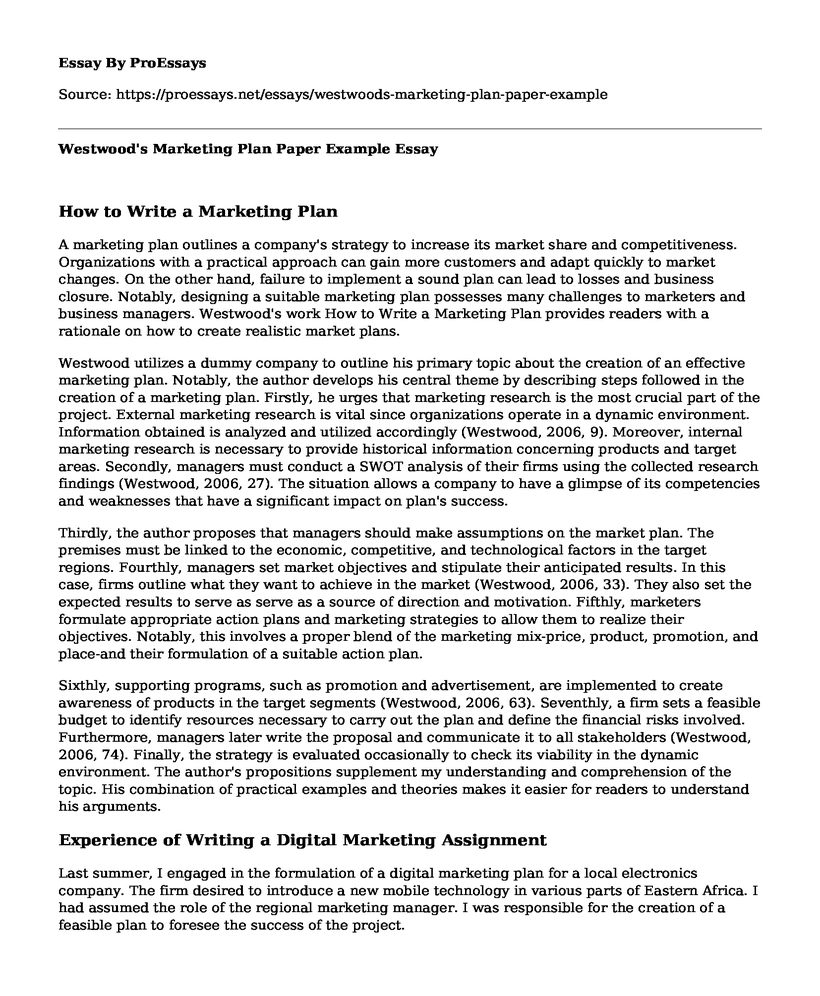How to Write a Marketing Plan
A marketing plan outlines a company's strategy to increase its market share and competitiveness. Organizations with a practical approach can gain more customers and adapt quickly to market changes. On the other hand, failure to implement a sound plan can lead to losses and business closure. Notably, designing a suitable marketing plan possesses many challenges to marketers and business managers. Westwood's work How to Write a Marketing Plan provides readers with a rationale on how to create realistic market plans.
Westwood utilizes a dummy company to outline his primary topic about the creation of an effective marketing plan. Notably, the author develops his central theme by describing steps followed in the creation of a marketing plan. Firstly, he urges that marketing research is the most crucial part of the project. External marketing research is vital since organizations operate in a dynamic environment. Information obtained is analyzed and utilized accordingly (Westwood, 2006, 9). Moreover, internal marketing research is necessary to provide historical information concerning products and target areas. Secondly, managers must conduct a SWOT analysis of their firms using the collected research findings (Westwood, 2006, 27). The situation allows a company to have a glimpse of its competencies and weaknesses that have a significant impact on plan's success.
Thirdly, the author proposes that managers should make assumptions on the market plan. The premises must be linked to the economic, competitive, and technological factors in the target regions. Fourthly, managers set market objectives and stipulate their anticipated results. In this case, firms outline what they want to achieve in the market (Westwood, 2006, 33). They also set the expected results to serve as serve as a source of direction and motivation. Fifthly, marketers formulate appropriate action plans and marketing strategies to allow them to realize their objectives. Notably, this involves a proper blend of the marketing mix-price, product, promotion, and place-and their formulation of a suitable action plan.
Sixthly, supporting programs, such as promotion and advertisement, are implemented to create awareness of products in the target segments (Westwood, 2006, 63). Seventhly, a firm sets a feasible budget to identify resources necessary to carry out the plan and define the financial risks involved. Furthermore, managers later write the proposal and communicate it to all stakeholders (Westwood, 2006, 74). Finally, the strategy is evaluated occasionally to check its viability in the dynamic environment. The author's propositions supplement my understanding and comprehension of the topic. His combination of practical examples and theories makes it easier for readers to understand his arguments.
Experience of Writing a Digital Marketing Assignment
Last summer, I engaged in the formulation of a digital marketing plan for a local electronics company. The firm desired to introduce a new mobile technology in various parts of Eastern Africa. I had assumed the role of the regional marketing manager. I was responsible for the creation of a feasible plan to foresee the success of the project.
I had a positive attitude towards the endeavor despite it being my first time to be in charge of such a delicate project. I was confident that my background knowledge in marketing was appropriate to undertake the activity. My primary reason for joining the marketing team was to gain practical experience necessary for my career development. Notably, the project was essential since it would reinforce my career development plan and harness my skills in marketing.
Throughout the project, I learned that teamwork played an essential role in the effectiveness of the team. The business environment is dynamic and requires proper scanning to identify suitable conditions that aid in the design of a marketing plan. Noticeably, just as Westwood stated, conducting marketing research is the most significant step in plan formulation. The marketing team undertook a thorough market scan to identify the existing opportunities that we could utilize to make our plan effective.
Furthermore, there is a significant link between Westwood's theory and our research design. For example, we carried out both internal and external market research, which aligns with the author's propositions. The author claims that a situation analysis enables a firm to identify strengths and weaknesses that relate to its threats and opportunities in the market (Westwood, 2006, 27). In our case, we discovered that our firm's reputation and extensive resources were our strengths in the market. Notably, I realized that the presence of low priced goods in East Africa would negatively, affect our product pricing.
My experience in designing the digital marketing plan was relevant to my studies. I incorporated most of the details stipulated by Westwood in the process. Additionally, the author's design procedure is excellent and is capable of producing exemplary results. Notably, although I faced various challenges in budgeting and advertising, the plan was a total success. In the future, I will apply Westwood's theory in the formulation of realistic and actionable marketing plans.
Conclusion
Overall, Westwood's work serves as a suitable guide in the formulation of perfect marketing design. The book covers all steps comprehensively and provides relevant examples to reinforce the primary topic. Through my experience, I consent with the author's set out procedure. It is incumbent on learners and managers to utilize the provided knowledge to develop their careers.
Reference
Westwood, J., (2006). How to write a marketing plan (Vol. 36). London: Kogan Page Publishers.
Cite this page
Westwood's Marketing Plan Paper Example. (2022, Sep 26). Retrieved from https://proessays.net/essays/westwoods-marketing-plan-paper-example
If you are the original author of this essay and no longer wish to have it published on the ProEssays website, please click below to request its removal:
- Marketing Strategy
- Paper Example on Marlboro Ads and American Culture
- Situational Analysis for the Cocoa Delights Organization
- Utilizing Kotter's 8-Step Model in Google Inc. Chinese Market Re-Entry Essay
- Essay on Maximizing Profits: Accurate Food Menu Design & Human Psychology
- Essay Example on Hospital Serving Community With Quality Care: Mission and Analysis
- Cash Flow Cycle: Generating Cash for Profitability & Liquidity - Essay Sample







